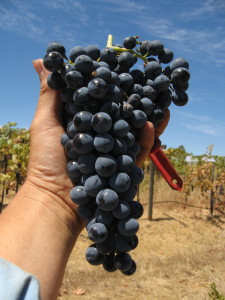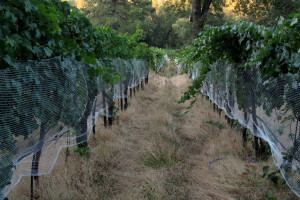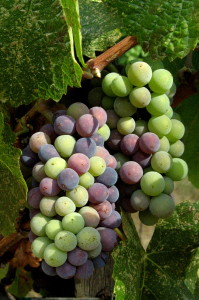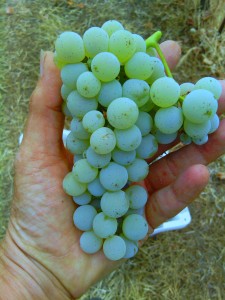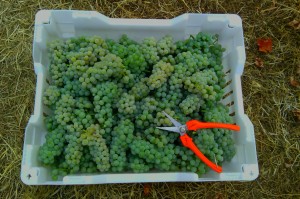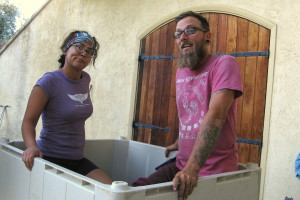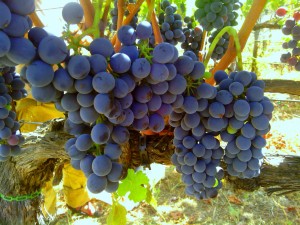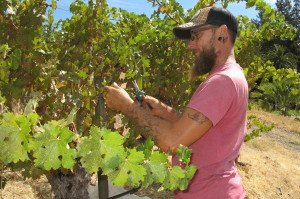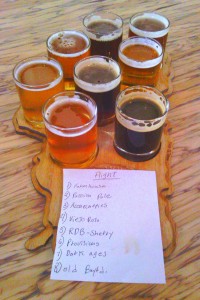My twentieth farm was Clos Saron in Oregon House, California.
The Farm
“Be on a path and let things happen.” Gideon’s philosophy.
The farmers are Saron and Gideon. The Home Vineyard is in the Sierra Foothills at 1,500 feet. The 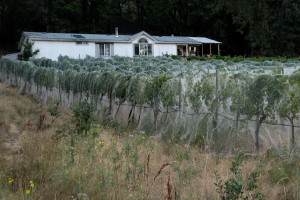 microclimate is ten degrees cooler than the surrounding area which allows Gideon’s favorite Pinot noir vines to flourish. Besides the vineyard, there is also a parade of sheep, rabbits, ducks, geese, and dogs, and a small vegetable garden. Gideon and Saron met while working in the vineyards of Renaissance Vineyards and Winery in Oregon House. The winery is part of the Fellowship of Friends, a cult group that is devoted to self-development. Gideon grew up in Israel. Saron grew up in the Gold Rush towns around Oregon House. While in his 20s, Gideon discovered a taste for wine. He helped plant the original vineyard at Renaissance in the 1970s. Then, in the 1980s, Gideon lived in France selling Renaissance wines and touring vineyards to learn from the experts about wine and French-style wine making. In the 1990s, Gideon returned to Renaissance, this time as the winemaker. He brought two new approaches to Renaissance’s German style wine making: a hands-off more natural method, and a French style blending of varietals to bring out the essence of the terroir. The wines met with immediate success. In 1995, Clos Saron started budding. A friend offered Gideon a half acre of vineyard to make his own wine. Gideon suspected that the cool micro-climate would favor his favorite Pinot noir grapes so Saron grafted Pinot vines unto their friend’s warm-weather-loving Cabernet Sauvignon and Merlot vines. They also planted more Pinot vines to double the vineyard. Three years later their friend sold them the land. Now Clos Saron has 4,500 Pinot noir vines over its 2.5 acres in the Home Vineyard, and a smaller, warmer vineyard with syrah vines up the road at a higher altitude.
microclimate is ten degrees cooler than the surrounding area which allows Gideon’s favorite Pinot noir vines to flourish. Besides the vineyard, there is also a parade of sheep, rabbits, ducks, geese, and dogs, and a small vegetable garden. Gideon and Saron met while working in the vineyards of Renaissance Vineyards and Winery in Oregon House. The winery is part of the Fellowship of Friends, a cult group that is devoted to self-development. Gideon grew up in Israel. Saron grew up in the Gold Rush towns around Oregon House. While in his 20s, Gideon discovered a taste for wine. He helped plant the original vineyard at Renaissance in the 1970s. Then, in the 1980s, Gideon lived in France selling Renaissance wines and touring vineyards to learn from the experts about wine and French-style wine making. In the 1990s, Gideon returned to Renaissance, this time as the winemaker. He brought two new approaches to Renaissance’s German style wine making: a hands-off more natural method, and a French style blending of varietals to bring out the essence of the terroir. The wines met with immediate success. In 1995, Clos Saron started budding. A friend offered Gideon a half acre of vineyard to make his own wine. Gideon suspected that the cool micro-climate would favor his favorite Pinot noir grapes so Saron grafted Pinot vines unto their friend’s warm-weather-loving Cabernet Sauvignon and Merlot vines. They also planted more Pinot vines to double the vineyard. Three years later their friend sold them the land. Now Clos Saron has 4,500 Pinot noir vines over its 2.5 acres in the Home Vineyard, and a smaller, warmer vineyard with syrah vines up the road at a higher altitude.
My Farming Experience
Wine, the New Gold
My reasons for coming to Clos Saron were twofold: to learn about something that was completely new to me, and to start to appreciate wine as much as I appreciate beer. My entrée to winemaking involved bird netting. I arrived in mid-June during a long period of drought. The 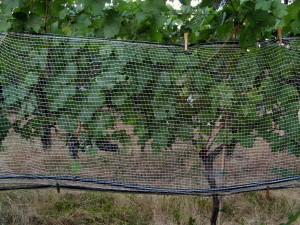 lack of water was bringing on an early harvest. The ripening grapes needed to be protected from birds, and quickly. So I spent my first week closing up the bird netting that was already covering the vines. I put clothes pins on the top and wiggled bamboo skewers through the netting on the bottom. Birds perching on wires and birds hopping on the ground would be thwarted from getting the grapes. It was a tedious job in the hot sun. Walking through the rows, foxtails lodged their barbs between my toes, and tar plants with their pretty yellow flowers turned my pants black and sticky. But I didn’t mind since it was for a good cause. Also, Thatcher, a former WWOOFer at the farm, and now a hired hand, was there working with me. As the days went along, Gideon checked the sugar level of the grapes. He had another vineyard named Vega Way in a much warmer microclimate at the top of the hill. The grapes at Vega Way were ripe and the birds were ready to pounce. Thatcher and I were sent up to get the bird netting on the vines. The rows at Vega Way are steep and have sharp thistles in the walkways. Between slipping on the dry grass and getting painfully poked in my sandaled feet I managed to pin down the netting. I secretly hoped to never have to come back to Vega Way again.
lack of water was bringing on an early harvest. The ripening grapes needed to be protected from birds, and quickly. So I spent my first week closing up the bird netting that was already covering the vines. I put clothes pins on the top and wiggled bamboo skewers through the netting on the bottom. Birds perching on wires and birds hopping on the ground would be thwarted from getting the grapes. It was a tedious job in the hot sun. Walking through the rows, foxtails lodged their barbs between my toes, and tar plants with their pretty yellow flowers turned my pants black and sticky. But I didn’t mind since it was for a good cause. Also, Thatcher, a former WWOOFer at the farm, and now a hired hand, was there working with me. As the days went along, Gideon checked the sugar level of the grapes. He had another vineyard named Vega Way in a much warmer microclimate at the top of the hill. The grapes at Vega Way were ripe and the birds were ready to pounce. Thatcher and I were sent up to get the bird netting on the vines. The rows at Vega Way are steep and have sharp thistles in the walkways. Between slipping on the dry grass and getting painfully poked in my sandaled feet I managed to pin down the netting. I secretly hoped to never have to come back to Vega Way again.
The reason I was being attacked by foxtails and thistles was Gideon’s use of natural farming methods. This method was popularized by Masanobu Fukuoka in his 1975 book The One Straw Revolution. One of its tenets is minimal weeding. Gideon explained that weeds keep the soil in place and attract pollinators and other beneficial insects. There were lots of bright orange monarch butterflies flitting around. Interestingly, Gideon doesn’t water the vines. In their search for water, the vines will grow deep roots up to thirty feet long. That way they can withstand a drought. If they are watered, they won’t grow deep roots and will die when they don’t get water. Gideon also doesn’t mess with pests. If a plant gets mites or aphids, he lets the pests eat that plant. Pests go for weaker plants and won’t bother the stronger ones. He lets nature control the grapes. Some years the flavor is more aggressive. The skill in winemaking, he said, comes in the processing.
“Be selective.” Gideon on harvesting grapes.
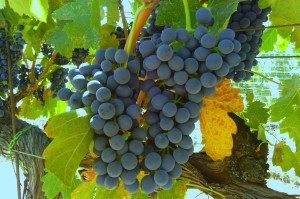 The skill in harvesting Gideon-style is judging which grapes are perfectly ripe and which are not. Commercial wineries harvest the entire crop when on average the grapes are ripe. With Gideon’s method, only the fully ripe grapes are harvested and the rest are left on the vines to continue ripening. It may take two or three passes through the rows before all the grapes get harvested. Using only the ripest grapes, the wine should be of a higher quality. The 2015 harvest started on July 23rd with syrah grapes on the sunny hillside of the treacherous Vega Way. “The grapes should be black (dark, dark purple), feel velvety, and, most importantly, feel a bit soft when you squeeze them–like a ripe avocado,” Gideon explained to Thatcher and me. “Don’t pick ‘Christmas lights’, green, red, or pink grapes. They aren’t ripe yet.” This seemed clear enough as I set off in calf high protective boots to my row carrying clippers and a harvest box. Most of my row was obviously ripe: the leaves had withered and turned brown. “The engine isn’t going anymore” Gideon commented. I took all the clusters until I got towards the bottom and found Christmas lights. Gideon checked my box and found only around twenty-five percent weren’t fully ripe. Good for a first time. To help me feel the difference, he showed me an unripe grape and a ripe. The unripe grape was hard and the ripe grape was soft. Easy. Then he gave me another unripe grape. It felt a bit soft too. Now I was confused. On my next row I only picked clusters that were squeezably soft like a nice roll of Charmin. This time all my grapes were ripe. But, Gideon wanted to know, had I left any clusters on the vines that I should have cut? Good question. There was a definite learning curve to knowing which grapes were ripe. I decided that was a nice goal to reach by the time I left the farm.
The skill in harvesting Gideon-style is judging which grapes are perfectly ripe and which are not. Commercial wineries harvest the entire crop when on average the grapes are ripe. With Gideon’s method, only the fully ripe grapes are harvested and the rest are left on the vines to continue ripening. It may take two or three passes through the rows before all the grapes get harvested. Using only the ripest grapes, the wine should be of a higher quality. The 2015 harvest started on July 23rd with syrah grapes on the sunny hillside of the treacherous Vega Way. “The grapes should be black (dark, dark purple), feel velvety, and, most importantly, feel a bit soft when you squeeze them–like a ripe avocado,” Gideon explained to Thatcher and me. “Don’t pick ‘Christmas lights’, green, red, or pink grapes. They aren’t ripe yet.” This seemed clear enough as I set off in calf high protective boots to my row carrying clippers and a harvest box. Most of my row was obviously ripe: the leaves had withered and turned brown. “The engine isn’t going anymore” Gideon commented. I took all the clusters until I got towards the bottom and found Christmas lights. Gideon checked my box and found only around twenty-five percent weren’t fully ripe. Good for a first time. To help me feel the difference, he showed me an unripe grape and a ripe. The unripe grape was hard and the ripe grape was soft. Easy. Then he gave me another unripe grape. It felt a bit soft too. Now I was confused. On my next row I only picked clusters that were squeezably soft like a nice roll of Charmin. This time all my grapes were ripe. But, Gideon wanted to know, had I left any clusters on the vines that I should have cut? Good question. There was a definite learning curve to knowing which grapes were ripe. I decided that was a nice goal to reach by the time I left the farm.
Next, we harvested white grapes at a vineyard on a Tennessee-Walker-horse-farm in Penn Valley. 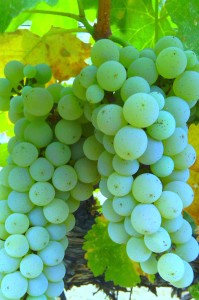 There were two other key people who were involved in the winemaking- Aaron and Lara, an impressive young couple from Florida who seemed straight out of a reality show. Trained chefs who had been part owners of Yuba Harvest Cafe, they became friends with Saron and Gideon over a year ago. Looking for new opportunities, Aaron and Lara decided to learn winemaking with Gideon as their mentor. Aaron with handsome stubble and a cell phone attached to his ear, always sounded confident, firm, and polite when he negotiated buying grapes. Lara and Aaron were learning the winemaking ropes along with Thatcher and me. Again Gideon started the day with a lesson on determining ripeness. With white grapes, the ripe ones are translucent, the unripe ones opaque. There will also be a softness and the grapes will hang loosely in the clusters, not tightly packed. Judging translucence on a grape seemed difficult. It was pointed out that the opaque grapes were greener and the ripe grapes whitish. We set off down our rows. I thought I was getting the hang of choosing the ripe grapes when I noticed that Aaron and Saron were leaving a lot of clusters on their rows whereas I was harvesting most of mine. I ate a few grapes. They tasted ripe to me. Sometimes we came across grapes that birds had pecked. Grapes with breaks in the skin could impart vinegar flavors into the wine. They could also introduce unwanted yeasts that could alter the termination. So they had to be picked off the clusters. Shriveled up grapes did too. They had concentrated sugar which would affect the wine taste. We harvested the amount we needed to add to the syrah from the other day. Together they would be blended to make a rosé.
There were two other key people who were involved in the winemaking- Aaron and Lara, an impressive young couple from Florida who seemed straight out of a reality show. Trained chefs who had been part owners of Yuba Harvest Cafe, they became friends with Saron and Gideon over a year ago. Looking for new opportunities, Aaron and Lara decided to learn winemaking with Gideon as their mentor. Aaron with handsome stubble and a cell phone attached to his ear, always sounded confident, firm, and polite when he negotiated buying grapes. Lara and Aaron were learning the winemaking ropes along with Thatcher and me. Again Gideon started the day with a lesson on determining ripeness. With white grapes, the ripe ones are translucent, the unripe ones opaque. There will also be a softness and the grapes will hang loosely in the clusters, not tightly packed. Judging translucence on a grape seemed difficult. It was pointed out that the opaque grapes were greener and the ripe grapes whitish. We set off down our rows. I thought I was getting the hang of choosing the ripe grapes when I noticed that Aaron and Saron were leaving a lot of clusters on their rows whereas I was harvesting most of mine. I ate a few grapes. They tasted ripe to me. Sometimes we came across grapes that birds had pecked. Grapes with breaks in the skin could impart vinegar flavors into the wine. They could also introduce unwanted yeasts that could alter the termination. So they had to be picked off the clusters. Shriveled up grapes did too. They had concentrated sugar which would affect the wine taste. We harvested the amount we needed to add to the syrah from the other day. Together they would be blended to make a rosé.
“You are discovering, not making mistakes.” Gideon telling me about winemaking. (Also a good philosophy on life.)
It was time to take off our shoes and stomp the grapes. Gideon uses traditional methods for making wine.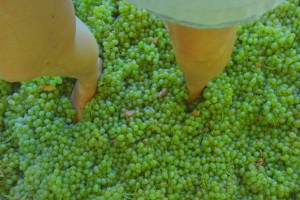 We looked at our dirty feet. Should we wash them first? “Everyone asks that,” Gideon chuckled. Washing wasn’t necessary because fermentation kills every thing, plus our feet might add some interesting yeasts. I climbed in to a large bin filled with white grapes. At first I was standing on top of the grapes, holding onto the sides of the bin for balance. The grapes were warm and springy. I marched around the sides of the bin, squishing the grapes towards the center. Grape juice started coming up to my ankles. Heavier people in the other bins had grape juice up to their knees. It was a good workout high-stepping on top the grapes. Eventually, there was mainly juice with a few floaters on top. These needed to be squashed too. Being light-weight, I took twice as long as everyone else to get my grapes to the right consistency. With the grapes squished, I was now two-feet lower in the high-walled bin. I needed help getting back out. The bins were covered with a heavy sheet and left outside for the wild yeasts in the air to do their work. The syrah grapes for the rosé didn’t get stomped. Stomping would bring out too much red color. Instead they went straight into the press which separates the juice from the skin and seeds of the grapes. Two men shoveled a bin full of the red syrah grapes into the monstrous-looking green press. Its bladder squeezed out the juice which ran through a tube into another bin to ferment. Now it was time to rinse off all the equipment so fruit flies wouldn’t be attracted. One young man stripped down to his white briefs, scooted under the press, and used a hose and bamboo skewer to tediously clean off all the grape parts from the nooks and crannies of the press. I washed my legs and went off to have a beer.
We looked at our dirty feet. Should we wash them first? “Everyone asks that,” Gideon chuckled. Washing wasn’t necessary because fermentation kills every thing, plus our feet might add some interesting yeasts. I climbed in to a large bin filled with white grapes. At first I was standing on top of the grapes, holding onto the sides of the bin for balance. The grapes were warm and springy. I marched around the sides of the bin, squishing the grapes towards the center. Grape juice started coming up to my ankles. Heavier people in the other bins had grape juice up to their knees. It was a good workout high-stepping on top the grapes. Eventually, there was mainly juice with a few floaters on top. These needed to be squashed too. Being light-weight, I took twice as long as everyone else to get my grapes to the right consistency. With the grapes squished, I was now two-feet lower in the high-walled bin. I needed help getting back out. The bins were covered with a heavy sheet and left outside for the wild yeasts in the air to do their work. The syrah grapes for the rosé didn’t get stomped. Stomping would bring out too much red color. Instead they went straight into the press which separates the juice from the skin and seeds of the grapes. Two men shoveled a bin full of the red syrah grapes into the monstrous-looking green press. Its bladder squeezed out the juice which ran through a tube into another bin to ferment. Now it was time to rinse off all the equipment so fruit flies wouldn’t be attracted. One young man stripped down to his white briefs, scooted under the press, and used a hose and bamboo skewer to tediously clean off all the grape parts from the nooks and crannies of the press. I washed my legs and went off to have a beer.
At 6:15 on another morning, we went off to Penn Valley again; this time for syrah grapes. Ripeness fluctuates along the rows as some areas get more sun than others. Frequently it would take a whole row to get twenty pounds of grapes to fill a box. This block of syrah grapes was solid black all down the long rows. Ten feet of vines filled a box which meant twenty pounds of grapes. Everyone was feeling jubilant at the quantity and ease of this day’s harvest. The sixty boxes we picked filled two small bins which were loaded into Aaron’s pickup truck. Following behind Aaron and Lara to keep an eye on the grapes, Thatcher and I did some math. We calculated the bins equaled one and a half barrels of wine which would fill 450 bottles. At $40 a bottle, there was $18,000 of future wine driving down the road. I had a new respect for grapes.
When there was a break in harvesting, Thatcher and I pruned the vines. This came with the risk that if we did it wrong, it could affect how well the vine fruited in the future. The first year vines were straight forward. Their job was to grow rapidly and straight. I popped off their suckers so just the one shoot would grow. Then I carefully tied the two-to-three-foot-tall shoot to a pole to keep it growing straight towards the five-foot-high fruiting wire. The older vines that were now fruiting were trickier. The main vine reached the fruiting wire and two lateral shoots were trained to run along the wire, one to the right and one to the left. This formed the permanent structure called a cordon. The suckers growing off the fruiting branches needed to be popped off to keep only one shoot growing and producing fruit. The only hard part of this was reaching some of the vines. Next, laterals growing out of the ground or on the trunk needed to be clipped off. Except, and importantly, one lateral, also called a renewal spur, needed to be left to become the new fruiting branch in a year or two. How this transition happened was unclear to me, but I understood that I needed to leave a strong new spur so the vine would continue to fruit well in the future. Frequently it was simple and fun. A tangle of two-foot laterals growing out of the ground around the base of the trunk needed to be cleaned up. I clipped out all but one nice looking lateral and tied it to its trunk to keep it growing straight. Now the vine looked much better. Some vines had a thin spur growing out of the trunk. This was a better situation for the vine. The higher the new spur the better. I left that spur and took off all the others. Of course there was the occasional vine where I inadvertently took off all the spurs. Like the one I cleared of all its ground level laterals to later discover that the spur growing out of its trunk was dead, and a couple of vines where I cut a lateral thinking there was one more, and there wasn’t. Oh well, it’s not like there’s a grape shortage on the farm.
Gideon used his new mini press to press the small batch of syrah grapes we picked the first day at Vega Way. After pressing the grapes once and collecting their juice, Gideon put the solids in the bed of his tractor, fluffed them with a pitch fork, and pressed them again. “That’s $250 worth of wine!” he exclaimed looking at the amount of liquid in the bucket from the second pressing.
There’s a more mundane side to getting a bottle of wine ready for sale. I spent one morning with a thumb sized clipper rounding the edges of the square wine bottle labels. Left square, the edges would come unglued when the bottles were put in the boxes. Once all the labels were clipped, I went to the winery and ran the labels through a hot glue machine before eyeballing them onto just the right place on the bottles. While I was reveling in my knack for putting labels on bottles straight, the new WWOOFer Karen was dipping the corked ends of the bottles into a crock pot filled with melted wax, When asked why he went to the trouble of waxing, Gideon responded that it was a more elegant way to seal the bottles.
Saron was the animal person and bread maker. Her menagerie of animals included a loud male sheep  named Mittens and a hissing male duck named Teapot. The two polar-bear-sized guard dogs rolled over each other in excitement when I walked by. Each morning when I was out working in the vineyard six of the geese would climb the small mound in their pen, unfold their wings, take a deep breath, and lift off the ground just enough to get over the fence. They headed for a flower patch, but after that was exhausted, they headed for the grapes. Unable to fly back into their pen, Saron rounded them up and sent them back through their gate. At around nine in the morning, I got the call to breakfast. Breakfasts were always omelets made with fresh duck and chicken eggs and sourdough bread dipped in quality olive oil and za’atar, a Middle East spice blend. I fell in love with the sourdough bread. The recipe, I learned, was from renown-baker Chad Robertson’s book Tartine. I vowed to learn to make bread like that when I returned to Seattle in the fall.
named Mittens and a hissing male duck named Teapot. The two polar-bear-sized guard dogs rolled over each other in excitement when I walked by. Each morning when I was out working in the vineyard six of the geese would climb the small mound in their pen, unfold their wings, take a deep breath, and lift off the ground just enough to get over the fence. They headed for a flower patch, but after that was exhausted, they headed for the grapes. Unable to fly back into their pen, Saron rounded them up and sent them back through their gate. At around nine in the morning, I got the call to breakfast. Breakfasts were always omelets made with fresh duck and chicken eggs and sourdough bread dipped in quality olive oil and za’atar, a Middle East spice blend. I fell in love with the sourdough bread. The recipe, I learned, was from renown-baker Chad Robertson’s book Tartine. I vowed to learn to make bread like that when I returned to Seattle in the fall.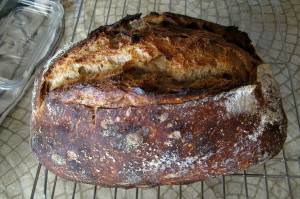
“There are fewer grapes this year but they are of high quality.” Gideon
I was curious to see what lay behind the high gates of the cult compound that housed Renaissance Winery. Aaron had negotiated for us to harvest some of the best quality cabernet sauvignon grapes, so at 6:30 one morning I entered through the gates of Apollo. The main boulevard is lined with palm trees, fountains, and busts of Apollo and other figures from mythology. After passing an opera house and Renaissance Winery, dirt roads lead up through the brown rolling hills of the vineyards. We stopped at Row 1, the most coveted of the cabernet sauvignon vines. As I started harvesting, I had trouble determining whether the grapes were soft enough to be fully ripe. When I asked Gideon about it, I discovered I’d been fondling grapes incorrectly. I had been squeezing individual grapes. Actually, you hold the entire cluster in your hand and give it a soft squeeze. If there is some give, they are ripe. The clusters were nicely ripe and it was a fun harvest day. It was also Saturday which meant fresh baked croissants were coming from the local cafe, Yuba Harvest. Sipping coffee and gazing at the rolling, endless landscape in the early morning sunlight, I was reminded of Italy. Once we harvested the amount that was negotiated for, we took them back to the farm to stomp. The red grapes are fun because they are colorful. However, after an hour of stomping and the cleanup that needs to be done to keep the fruit flies away, I was ready to relax over a nice meal and wine. Yuba Harvest has mouth-watering grilled burgers on weekends. Gideon put a couple of bottles of wine into his green wine bag and we all headed out for dinner after a satisfying day.
On my second to the last day on the farm, we harvested pinot noir grapes at the Home Vineyard. My ghostly row had vines draped to the ground in white bird netting. Inside the netting it was hard to see the color of the dark grapes. Many burst in my hands when I fondled them testing for ripeness. Obviously they were overripe, I assumed, but went ahead and picked them. After harvesting grapes for much of the last two weeks, I felt I had the basic knack for determining ripeness. As my bin filled, Gideon came over to check my work. The grapes weren’t ripe, he said. They were pink. Pink? I held them up to the good lighting outside the netting and couldn’t see pink. Why would they burst in my hand if they were under-ripe? I was confused. On my next rows I only took clusters that looked very dark. Gideon came by and told me I was missing a lot of ripe grapes and to go down the rows again more carefully. So much for my earlier goal of being able to determine basic ripeness by the time I left the farm. My confidence shattered, I slowly whiled away my time looking back through the rows I’d already done while the others finished the section of grapes that were being harvested that day.
On my two days off I explored the area. The small towns around Oregon House were founded during the Gold Rush. I was most interested in learning the story of how it all started so I drove to Marshall Gold State Historic Park on the American River. There I found the site of Sutter’s mill. John Sutter needed a mill to make lumber for the settlement he was building on the Sacramento River. He hired James Marshall to build it. On the morning of January 24th, 1848, as Marshall was checking the tailrace for debris, he noticed flecks of gold. Word of the discovery eventually got out and gold seekers from around the world rushed to the Sierra Foothills in the spring of 1849. Today a quiet neighborhood sits among the historic sites from one of the most famous events in American folklore. On another day, I found the site of a notorious event at Donner Pass. The unfortunate Donners and their group decided to take a short cut on their way to California, but the guide they hired didn’t stay with them. The short cut took longer than expected and they ended up behind the pioneers who had stayed on the main track. To make matters worse, a strong, early storm came in and stopped them at the pass. They couldn’t get out, and rescue parties couldn’t get in until the spring. They were next to a lake but apparently didn’t know how to fish. They were rich city folks without survival skills. It’s really amazing any of them survived that winter. A few kept journals and recorded several incidents of cannibalism. Would they be remembered if they hadn’t eaten human flesh? The site is on a large picturesque lake with a campground, motor boats, and crowds. Hardly a spot to contemplate their winter. A new museum has a nice documentary and exhibits that give a good perspective of what they went through. After the sobering experience at the pass, I drove to Lake Tahoe Brewing Company in Truckee where I had a sampler of their complex beers while musing away in my journal.
On my final morning at Clos Saron I helped harvest at Vega Way. The days were shorter now in the middle of August, so it wasn’t until after seven that the light was sufficient to judge the color of the grapes for ripeness. Everyone was in good spirits even though the rows were steep, the bins heavy with large clusters of grapes, and it was hot. The grapes were ripe so it was worry-free harvesting. After the Sunday morning croissants and coffee, I said good-bye. I had decided to spend three days in the wine valleys of Sonoma, tasting wine and looking at manicured vineyards. But unlike the other wine-tasting-tourists, my hands were black from the experience of harvesting grapes that were destined to make fine wine.